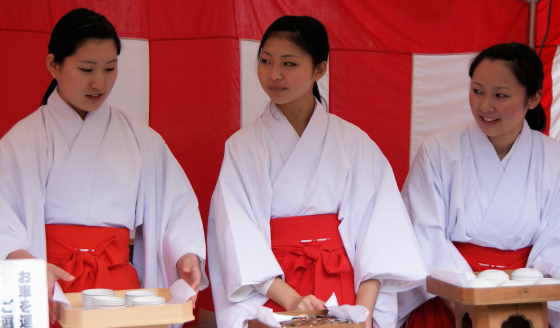The grand torii on the road leading to Izumo Taisha, often called the second most important shrine in Japan, and often claimed to be the oldest shrine in Japan. While the first claim is debateable, the second is pure fantasy.
According to the ancient chronicles, a "palace" was built here by the Yamato to thank Okuninushi for giving Japan to them. As this happened before the Yamato descended from heaven, and as history in Japan begins with the Yamato in the same way that some believe the history of America begins with Columbus, therefore this must be the first shrine in japan.
One legend has it that the shrine was first built in the mid 7th Century. That sounds reasonable to me, as that was when several shrines were built in the Izumo area by the Yamato "emperors".
Though few question that Okuninushi is enshrined here, there is a reasonable doubt. In the sixteenth Century all buddhist buildings and images were removed from the shrine. At that time the records of Gakuen-Ji were consulted. Until this point Gakuen-Ji had administered the shrine, and the temple records go back further than the shrines. The temple records say it was Susano enshrined here. Since the beginning of Yamato hegemony over this part of japan there has been a continuous process of denigrating Susano and elevating Okuninushi.

What is undisputed is that the Honden of Izumo Taisha is the biggest in japan. The current one, constructed in 1744 is 24 meters high, but Heian period documents claim it was double that height, making it the tallest building in Japan at that time. This height was long believed to be exaggerationm but in 2000 excavations revealed the bases of huge pillars made by strapping three pillars together. In front of the entrance to the shrine is a small museum with models of what this original structure may have looked like, and at the nearby Shimane Museum of Ancient Izumo there are more models . Apparently the tall structure was not based on sound engineering and it repeatedly collapsed until about the 12th Century when its reduced size was settled on.

Running alongside both sides of the main shrine are two rows of small shrines. These are "motels" for the kami. Once a year, in the Fall it is said that all the kami of Japan meet up here in Izumo. They don't meet at Ise, and they don't meet in Yamato.
Actually all the kami don't come. It is said that Ebisu doesn't come, even though his home shrine is nearby, because he is deaf and doesnt hear the call. Other kami make all kinds of excuses not to come..... too busy, cant afford it etc. I have heard of a shrine in Wakayama that holds a matsuri celebrating that their kami doesnt go.
Next to the main shrine is the Kagura Den, adorned with the biggest shimenawa in the world. If you visit here chances are that you will see a wedding. I've heard it said that Izumo taisha is the most desired location for weddings in japan.
The groom certainly does not seem very happy. Maybe he just got the bill.
In early-modern times Okuninushi became known as a matchmaker, and now lots of young people come to Izumo Taisha to pray for a spouse.
Every time I've been there young women have outnumbered young men by a factor of 3 or 4.
In the main compound, alongside Okuninushi, are enshrined Suserihime (Susanos daughter who Okuninushi married), Tagirihime (another daughter of Susano, one of the 3 Munakata princesses, and Kisagaihime and Umugaihime, 2 female kami who resurrected Okuninushi after he was killed by his 80 brothers. All female kami.
Behind the main compound is the Soganoyashiro, a shrine to Susano.


































